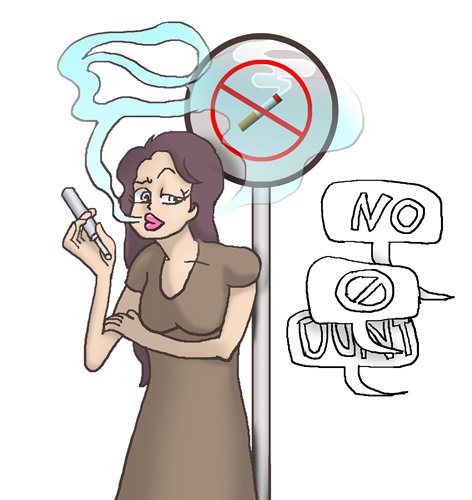- Home > News > Domestic News
- domestic news
Smoking ban must extend to include e-cigarettes

Illustration: Lu Ting/GT
Controversies surrounding e-cigarettes have been rising. A video shared on social media quickly went viral in late July, in which a young woman smoking an e-cigarette aboard a Beijing subway train, argued with an old gentleman who was trying to persuade her to stop smoking.
"You are so ignorant. I'm not smoking a cigarette!" The woman angrily rebuked the man. A security guard who supposedly maintained order onboard the subway, stood near the argument, but he failed in his attempts to persuade the woman. Two other women who were sitting beside the smoking women stood up and left the video scene, apparently annoyed by either the smoke or the argument.
Despite the protest by the old gentleman, the woman continued to smoke the e-cigarette defiantly. She got off the train carriage when arriving at her station, apparently continuing the enjoyment of the smoke even inside the subway station.
A smoking ban has long been announced in the Beijing subway system. Beijing has also issued its municipal tobacco control ordinance. However, the Chinese words "jinzhi xiyan" in the regulation text are open to interpretation. Literally, the Chinese words mean "ban the use of smoke," but it is unclear whether the ban covers "e-cigarette smoke" on top of "traditional cigarette smoke."
The same ambiguous problem affects other cities and urban public transportation systems as well. Smoking bans were announced years ago when e-cigarettes were nonexistent or barely appearing in the Chinese market. In recent years, with clever marketing, e-cigarettes have risen as a fashionable way to "enjoy smoking," catering to young metropolitans across China, many of whom wrongly believe e-cigarettes are totally harmless, with some even proudly touting vaping as a way of modern metropolitan life.
I'm worried by the clever vape marketing campaign that has certainly led to a situation whereby basic facts about e-cigarettes evade the general public. To create an experience that mimics traditional smoking, an e-liquid that generally consists of propylene glycol, glycerin, and, most importantly, nicotine, is used.
Good science tells us smokers only get the maximum health benefit if they completely quit all nicotine use, even though e-cigarettes generally have less nicotine contents than traditional cigarettes. It is also worth noting that e-cigarette makers even add certain flavors to their products so as to better entice consumers who would either try out or switch to a new smoking experience.
Some may argue that e-cigarettes offer a credible step toward smoking cessation, and currently available research seems to prove this, particularly when heavy smokers completely stop traditional cigarettes and use e-cigarettes instead. However, the aerosolized vapor from e-cigarettes still represents a source of secondhand smoke that poses real danger to people's health.
With the ambiguity of the current smoking ban, many e-cigarette smokers believe the ban does not apply to them, and some even believe that smoking e-cigarettes is a sign of higher level of consumer sophistication, as was the case of the arrogantly ignorant young woman on the Beijing subway.
I would urge subway authorities and city planners to take immediate action and address the ambiguity problem by banning e-cigarettes outright. Actually, civil aviation authorities and CRH trains have long explicitly banned e-cigarettes, and the practice has been well received by the general public without any controversy.
Understandably, the implementation of an outright ban takes time. Therefore, when current regulations are vague and take time to revise, concerned citizens and public health organizations must raise awareness about e-cigarettes.
To turn the tide against many years of successful, smart marketing campaigns, the bottom line is that the myth of fashionable metropolitan e-cigarette smokers who get to enjoy some nicotine-stimulated pleasure without any health hazard has to end.
| Chinese Association on Tobacco Control Copyright © 1992-2011 906-907 Anhuidongli, Chaoyang District Beijing 100101 |